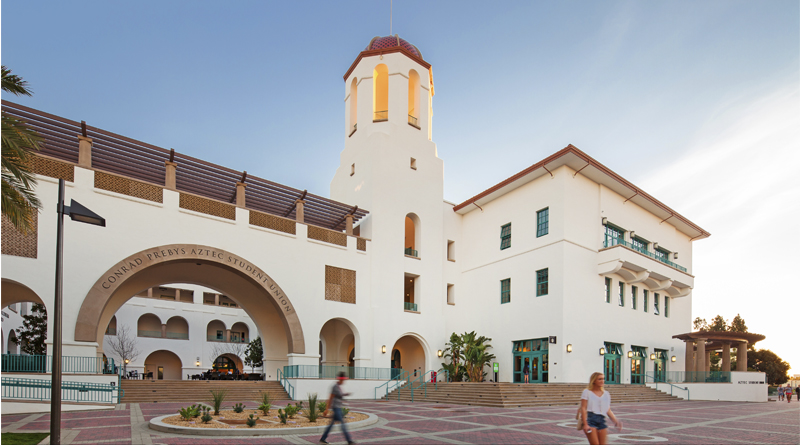By Rachel Leber
SAN DIEGO — San Diego State University (SDSU) just received LEED Double Platinum certification status for its new Conrad Prebys Aztec Student Union. Achieving double platinum status is a rare honor that approximately only 20 other buildings in the U.S. have been given, according to Glen Brandenburg, director of facilities and sustainability at SDSU. The construction of this 205,000-square-foot building began in June 2011 with a budget of $100 million and opened in January 2014, however, only just recently received LEED Double Platinum honors in December 2016.
Sustainability has been an important aspect of community life at SDSU since at least 2008, according to Brandenburg, when the students passed a referendum to spend more money on green buildings, and created an organization known as the Green Love Sustainability Advisory Board. The referendum in 2008 had quite a lasting impact, with the proof that the university plans to be 100 percent LEED-certified by the year 2020. Two buildings remain that still require LEED certification, according to Brandenburg — the 13,000-foot Viejas Arena and the Aztec Aquaplex Pool Complex still remain to be updated by the 2020 projected deadline.

Photo Credit: Quentin Skaggs
“As someone representing the student body’s voice on sustainability concerns, it’s an invigorating feeling being able to witness one of our university’s buildings achieve the LEED Double Platinum award. Not only does the student-body look to the university to fulfill it’s promise of being a leader in sustainability, but we hope to be part of a tangible change outside of the classroom,” said Shelah Ott, Green Love Sustainability Advisory Board Commissioner for Associated Students at SDSU.
To qualify for certification from the USGBC, each project must follow strict LEED guidelines. When asked about how the new student union fulfilled their double platinum certification, Brandenburg listed several green features of the building: a cool roof, a green roof (a roof with a garden and plants growing), mission-style architecture (a passive-efficiency building style), double-pane windows and high levels of insulation. There are solar panels on the student union as well as the parking structure, which power 50 percent of the building’s electricity needs in the winter and 60 to 65 percent in the summer, according to Brandenburg. The lighting fixtures are almost exclusively LED and there are low-flow toilets and waterless urinals in the restrooms.
When asked what “double platinum” status actually means, Brandenburg explained that there are two ways a building can gain platinum status: one is for “new” construction, which is simply for the construction of a green building, and one is for EBOM — existing building operations and maintenance — for actually operating the building in a LEED-certified manner. “Even for a building that was built as ‘LEED-new’ certified, it’s still important to certify it for operations, because though it was built in a green way, it does not necessarily mean that it is in fact operating sustainably, or may not be up to the standard that it could be operating at. The potential is great in a LEED new-construction building, but you have to have the attention to detail to make it work sustainably.”
The process to gain certification took several years, which was one of the biggest challenges in actually obtaining the certification, according to Brandenburg. Brandenburg said that the high amount of paperwork due to the level of detail needed to meet green building standards was a challenge. When asked about the goals of green building, he said generally it is about keeping the occupants happy and using as little energy as possible. “It’s about the big picture. The result of doing a good job and being meticulous is having happy and healthy occupants,” he said.
“The Conrad Prebys Aztec Student Union definitely deserved the award,” said Robert Schulz, university architect and associate vice president of operations at SDSU in a statement. “This is a major accomplishment, and we are all deeply proud that the university could make it happen.”


